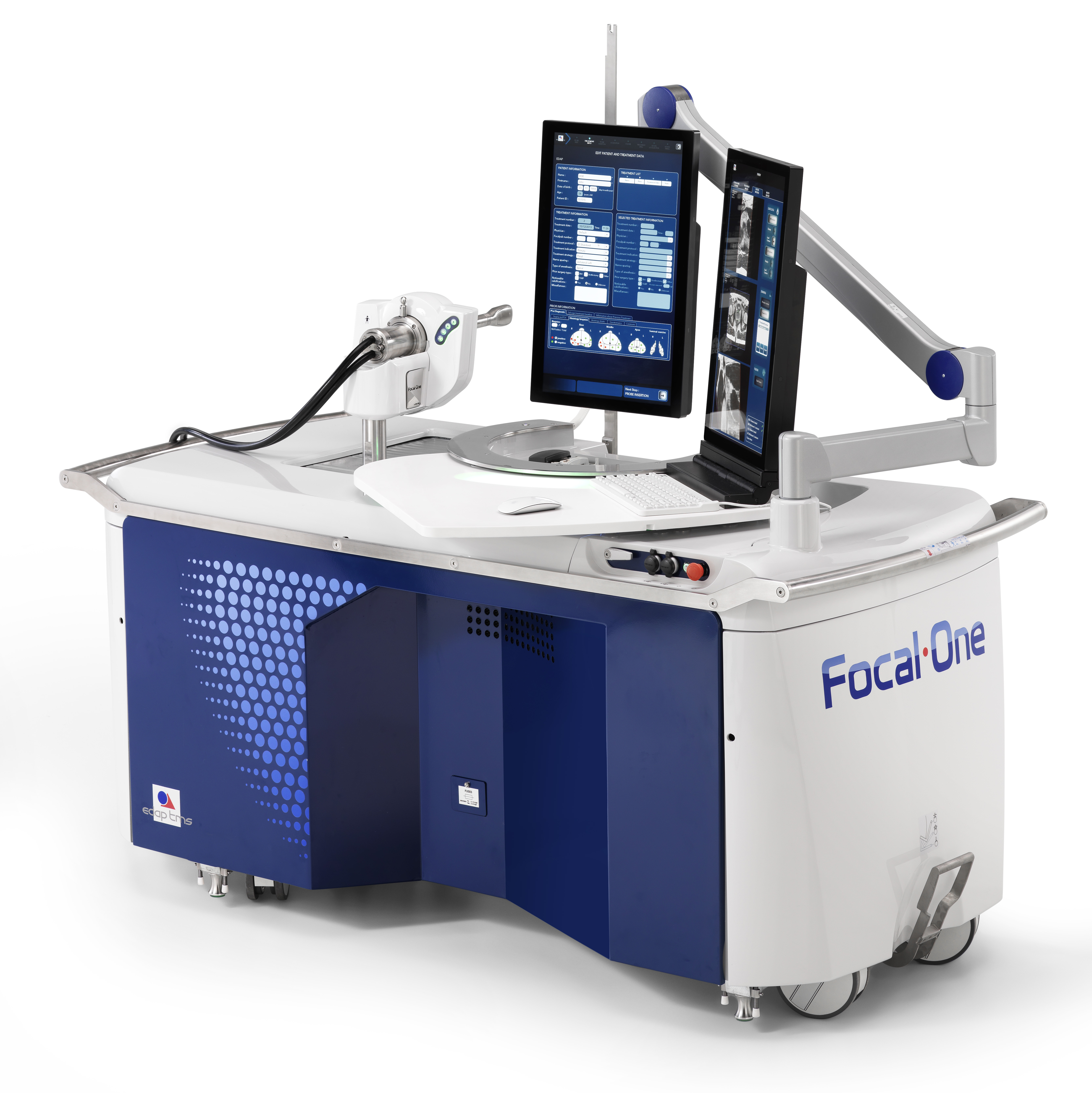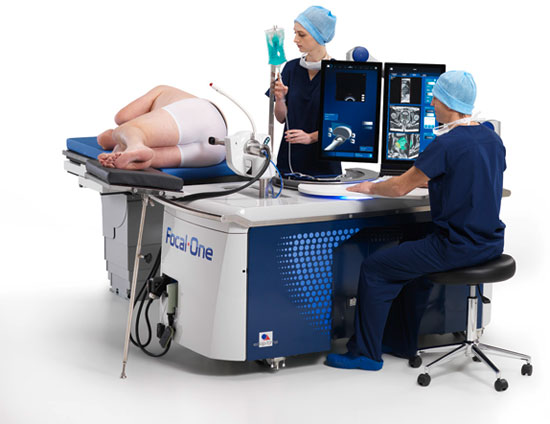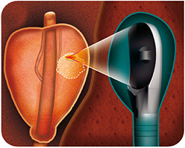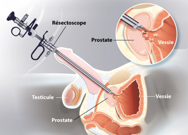
Cancer de la prostate : le FOCAL ONE® A L’HOPITAL FOCH
Publié le par Communication Urologie Foch chez Urologie Foch . Modifié leL’hôpital FOCH a tout récemment fait l’acquisition d’un Focal One®, appareil permettant le traitement du cancer de la prostate par ultrasons focalisés à haute intensité (HIFU).

Le cancer de prostate – le plus fréquent chez l’homme en France – lorsqu’il est localisé est le plus souvent accessible à un traitement à visée curative, par chirurgie (prostatectomie totale), radiothérapie externe, curiethérapie et aussi par ultrasons focalisés (HIFU).
Le traitement par HIFU est une technique de chirurgie du cancer de la prostate mini invasive ; il n’y aucune incision et aucune irradiation. Le principe est de détruire les tissus cancéreux prostatiques grâce à la chaleur obtenue par la focalisation des ultrasons à haute intensité.
Le Focal One® est la toute dernière génération d’appareil d’HIFU. Il est de conception française. Son apport essentiel par rapport aux autres appareil d’HIFU est la possibilité d’augmenter la précision des zones de traitements.
L’avantage de cette technique pour le patient est de pouvoir minimiser l’impact négatif sur les organes de voisinages, et donc impacter au minium la qualité de vie :
- le sphincter urinaire, les bandelettes nerveuses sont épargnés et on observe donc moins de dysfonction érectile et nettement moins d’incontinence urinaire que pour les traitements par prostatectomie ou radiothérapie
- en évitant les radiations, on n’affecte pas les organes tels la vessie et le rectum.
Le Focal One® apporte des options innovantes avec notamment, la possibilité de prendre en compte l’imagerie par IRM de prostate réalisée avant le traitement ; grâce à l’intégration des images, dans l’appareil, le chirurgien peut définir précisément la zone pathologique de la prostate et donc la zone à traiter.
De même, la localisation des biopsies de prostate réalisées par fusion d’images (système Koelis, que nous utilisons à Foch) est intégrée au Focal One® durant le traitement dans ce même but d’être le plus précis possible sur la zone de traitement.
L’imagerie de contraste quant à elle, permet un contrôle immédiat, pendant l’anesthésie, de la zone qui a été traitée. Si nécessaire, dans le même temps opératoire, une éventuelle zone insuffisamment traitée peut être retraitée.
Les traitements par HIFU sont indiqués dans plusieurs situations :
- chez un patient dont le cancer est localisé à la prostate
- en cas de récidive après un premier traitement par ultrasons
- en cas de récidive locale après radiothérapie.
Dans les quelques cas de récidive locale après traitement par HIFU, il reste la possibilité d’un nouveau traitement par ultrasons ou par chirurgie conventionnelle (prostatectomie).
Les traitements peuvent se faire sur la glande prostatique entière ; comme les traitements radicaux que sont la prostatectomie ou la radiothérapie.
Mais, ils peuvent aussi être réalisés sur une zone définie et limitée de la prostate, ce qui définit le traitement focal du cancer de la prostate. Ces traitements ont pour objectif d’avoir la même efficacité sur le cancer que les traitements radicaux mais sans incontinence urinaire ou dysfonction érectile.

Ces traitements focaux sont en cours d’évaluation dans différents protocoles mais des publications majeures récentes permettent d’envisager ce type de traitement en toute sécurité (1).
En pratique :
Le traitement se fait sous anesthésie générale ou rachi anesthésie, par voie endorectale, sous contrôle échographie permanent permettant de contrôler et de cibler les zones que l’on souhaite traiter.
Afin de diminuer le volume prostatique et donc le risque de rétention d’urines post opératoires, le traitement par HIFU est associé à une résection endoscopique (par les voies naturelles) de la partie centrale de la prostate. Cette résection de prostate se fait soit dans le même temps opératoire soit quelques semaines avant le traitement par HIFU.
 Le traitement dure entre 30 min et 2h en fonction du volume prostatique à traiter.
Le traitement dure entre 30 min et 2h en fonction du volume prostatique à traiter.
L’hospitalisation se fait en ambulatoire ou sur une hospitalisation de 2 jours avant des gestes associés (résection dans le même temps).
Une sonde urinaire est laissée en place après l’intervention pour une durée variant entre 3 et 7 jours.
Les suites opératoires sont marquées par une irritation au moment d’uriner qui disparaît en quelques jours.
La surveillance se fait par des dosages de PSA total réguliers.
EDAP Announces Focal One® HIFU Sale to Foch Hospital, Paris
Growing Adoption of Focal One HIFU in France
LYON, France, December XX, 2016 – EDAP TMS SA (Nasdaq: EDAP), the global leader in therapeutic ultrasound, today announced the sale of a Focal One system to Foch Hospital, Paris, one of the largest private Hospital in the Paris Area.
Based on successful HIFU treatments performed in the last two years under a Revenue-per-procedure (“RPP”) contract, Foch Hospital decided to acquire the Focal One system and offer this minimally invasive option to its prostate cancer patients.
Pr. Thierry Lebret, Head of Urology and Kidney Transplantation Department at Foch Hospital, and recently appointed President of French Urology Association, commented: “Our team is very enthusiastic to add Focal One HIFU therapy to our portofolio of solutions offered to selected prostate cancer patients. Focal One offers an ideal combination of state-of-the-art IRM and real-time ultrasound imaging capabilities together with targeted HIFU technology capable of highly precise ablation of prostatic tissue, with reduced side effects”.
Pierre Reboul, EDAP TMS France Business Unit Director, added: “We are very pleased with this Focal One acquisition by the prominent Foch Hospital, under the management of Pr. Lebret. This investment confirms the growing adoption of focal HIFU in the management of prostate cancer in France, as demonstrated during the recent French Urology Association Congress, held in Paris last November. Our HIFU club, organized during this event, gathered more than 50 French Focal One users who shared their experience and appetite for the technology. Our live demonstrations of our focal HIFU system on EDAP’s booth indeed recorded a great success. We look forward to bring HIFU focal treatments to a growing number of prostate cancer patients.”
Marc Oczachowski, EDAP’s Chief Executive Officer, concluded: “Interest for our innovative HIFU technologies is clearly growing as we continue to open and train new sites in France, but also in the rest of the world. In addition, it supports our belief that Focal One has the potential to become a must-have therapeutic option in today’s prostate cancer treatment management.”
About EDAP TMS SA
EDAP TMS SA markets today Ablatherm® for high-intensity focused ultrasound (HIFU) for prostate tissue ablation in the U.S. and for treatment of localized prostate cancer in the rest of the world. HIFU treatment is shown to be a minimally invasive and effective option for prostatic tissue ablation with a low occurrence of side effects. Ablatherm-HIFU is generally recommended for patients with localized prostate cancer (stages T1-T2) who are not candidates for surgery or who prefer an alternative option, or for patients who failed radiotherapy treatment. Ablatherm-HIFU is approved for commercial distribution in Europe and some other countries including Mexico and Canada, and has received 510(k) clearance by the U.S. FDA. The Company also markets an innovative robot-assisted HIFU device, the Focal One®, dedicated to focal therapy of prostate cancer. Focal One® is CE marked but is not FDA approved. The Company also develops its HIFU technology for the potential treatment of certain other types of tumors. EDAP TMS SA also produces and distributes medical equipment (the Sonolith® lithotripters’ range) for the treatment of urinary tract stones using extra-corporeal shockwave lithotripsy (ESWL) in most countries including Canada and the U.S. For more information on the Company, please visit http://www.edap-tms.com, and http://www.hifu-planet.com.
Forward-Looking Statements
In addition to historical information, this press release may contain forward-looking statements. Such statements are based on management’s current expectations and are subject to a number of risks and uncertainties, including matters not yet known to us or not currently considered material by us, and there can be no assurance that anticipated events will occur or that the objectives set out will actually be achieved. Important factors that could cause actual results to differ materially from the results anticipated in the forward-looking statements include, among others, the clinical status and market acceptance of our HIFU devices and the continued market potential for our lithotripsy device. Factors that may cause such a difference also may include, but are not limited to, those described in the Company’s filings with the Securities and Exchange Commission and in particular, in the sections “Cautionary Statement on Forward-Looking Information” and “Risk Factors” in the Company’s Annual Report on Form 20-F.
# # #
- Focal High Intensity Focused Ultrasound of Unilateral Localized Prostate cancer: A Prospective Multicentric Hemiablation Study of 111 Patients Rischmann et a., Eur Urol. 2016 Oct 6. pii: S0302-2838(16)30679-0.